BUSINESS INSIGHTS | How To Do SEO – Beginner’s Guide.
- Camilla Gleditsch

- Sep 2, 2021
- 12 min read
Updated: Oct 12, 2021

Free, high quality and consistent. This is the exact type of website traffic that every shop owner wants. So buckle up, because in this article, I'll teach you how to increase sales and grow your business by learning search engine optimization (SEO).
SEO can be overwhelming for business owners. Where to begin? Between buzzwords like SERP and Google's algorithm, the subject of SEO to a beginner can feel as distant as flying to the moon. But it doesn’t have to be that way.
In fact, it’s sad that so many miss out on this free, predictable, high-quality traffic tool. Why does this happen? Because SEO is not explained in a way that is easy to understand. With that in mind, I will take you guys through what is SEO and how it works in a way that feels simple and is, above all, actionable.
This is part 1 of 2 for our "How to Do SEO" series. The first article is going to show you how to do SEO for your website and your eCommerce page using effective and simple SEO practices. Next week's article will take a deeper look at localised SEO. I will discuss how you can optimize your Google My Business listing so that you can drive more foot traffic to your brick-and-mortar store and better rank for terms like "wedding suits nearby".
Whether you decide to do SEO yourself or choose to hire someone to help you, I hope that these articles will give you a greater understanding of how it all works.
This first article covers:
Let's first cover a couple of key SEO terms that will be referenced throughout this article.
The SEO glossary.
Your answer to what is...
Search volume: The number of times that users search for a given term.
Long-tail keyword: Long-tail keywords are three or four words long, that people type into Google.
Meta descriptions: Meta descriptions are basically the paragraphs underneath the blue headline on Google. An image reference can be found in this article.
Title Tag: When you conduct a search on Google, the title tag is the blue clickable headline that appears on the results page. An image reference can be found in this article.
Alt-text: Alt text tells Google what a picture is about.
#1. What is SEO and how it works?
If you are completely new to this subject, you might even be thinking, what is SEO?
Search engine optimization (SEO) is the process by which content is created and enhanced in a way that makes finding them on search engines like Google, YouTube, Yahoo, and Bing easier.
When you type a search term into Google, the search engine result page, also called SERP, gives us a few paid ads and 10 organic unpaid search results below them.

The goal of SEO is to rank within these 10 organic search results. The cherry on top is being listed on Google's first page.
Most people do not click past the first page of Google results when searching for things. You probably know this from your own experience. But, that is not to say that pages beyond Google’s 1st page don't get clicks. Actually, according to Ignite Visibility, the chances of a person clicking beyond Google’s 1st page is something like this:

The following is an example of traffic generated for Irish Retailer - EJ Menswear - from Google search pages after the initial first page. Even though they rank on page seven of Google, they still receive visitors from the keyword "Tommy Hilfiger t shirt".

#2. Why is SEO important?
According to Think with Google, 63 per cent of shopping occasions begin online.
So regardless of where customers make their final purchase (online or in brick-and-mortar stores), their customer journey starts online. As a result, if the right search term is targeted, and implemented on your website, this can lead to a lot of sales.
Search terms are grouped into these categories.
a) Navigational search queries.
Search terms such as these are types of terms that you type when you are trying to find information on a specific website.
For example, when you are looking for"upselling & cross selling techniques for shop owners", you might type "RJ MTM blog".
b) Informational search queries.
These are the types of search terms you use when trying to gather knowledge or conduct research.
For example, when you are looking to build an online store you might search for how to build an eCommerce site and later on ask Google - what is SEO?
c) Transactional search queries.
As a shop owner, you should pay the most attention to these types of search terms.
Usually, your potential customers will type in these words when making a commercial decision.
For example, when they need a new suit for a wedding, they might type in, “wedding suits nearby”.
Now that we have a bit of background knowledge about SEO, let's get started.
#3. SEO keyword research report.
The user's journey begins with a search term, so it shouldn't surprise you that our process starts with SEO keyword research.
When conducting keyword research, people often care most about keywords that get a lot of searches.
In my experience, anyone who isn't doing SEO for the purpose of creating a movement should focus more on the quality of those visitors rather than the number of visitors.
In other words, every shop owner should prioritise quality over quantity.
Traffic is great, but we want people to come to us for the right reasons. We want to attract visitors who are likely to buy our products. That’s why we want to rank for the right keywords that show buying intent. And these are most likely going to be transactional search queries.
Examples of transactional search queries are:
3-piece wedding suit
Shop men's overcoats
Since Google is the most popular search engine on the planet, I will show you how to conduct keyword research using Google, but you can use similar methods on other search engines as well.
We start our research with Google's autocomplete feature to locate the right keywords.
Google’s autocompleting feature.
Long-tail keywords can be found easily with the auto-complete feature. According to Backlinko, 92% of all search queries are long-tailed keywords.
People also search for.
The related searches section (see image below) is another great resource for keyword ideas. You can find a wealth of keyword ideas in these sections, and they are a great place to begin.

Author's tip: If you use this process on Google, watch out for long-tail keywords.
Why are long tail keywords important for SEO? Because they are more specific, they often have lower competition and higher conversion rates.
If you're just starting out, these strategies are great, but a keyword tool is highly recommended if you have a little bit of money to spend.
A keyword tool can help you find better keywords in a more efficient manner.
Free recommended keyword tools:
SEMrush (10 free searches per day)
Paid recommended keyword tools:
I did a quick keywords research for men's clothing related searches in Ireland and the United Kingdom and found that both Made To Measure suits, Tailored made suits and Custom suits were good keywords with low competition and good search volumes (more on how to evaluate a good keyword later). So it's also a fantastic tool for finding out what the market wants and are currently looking for.
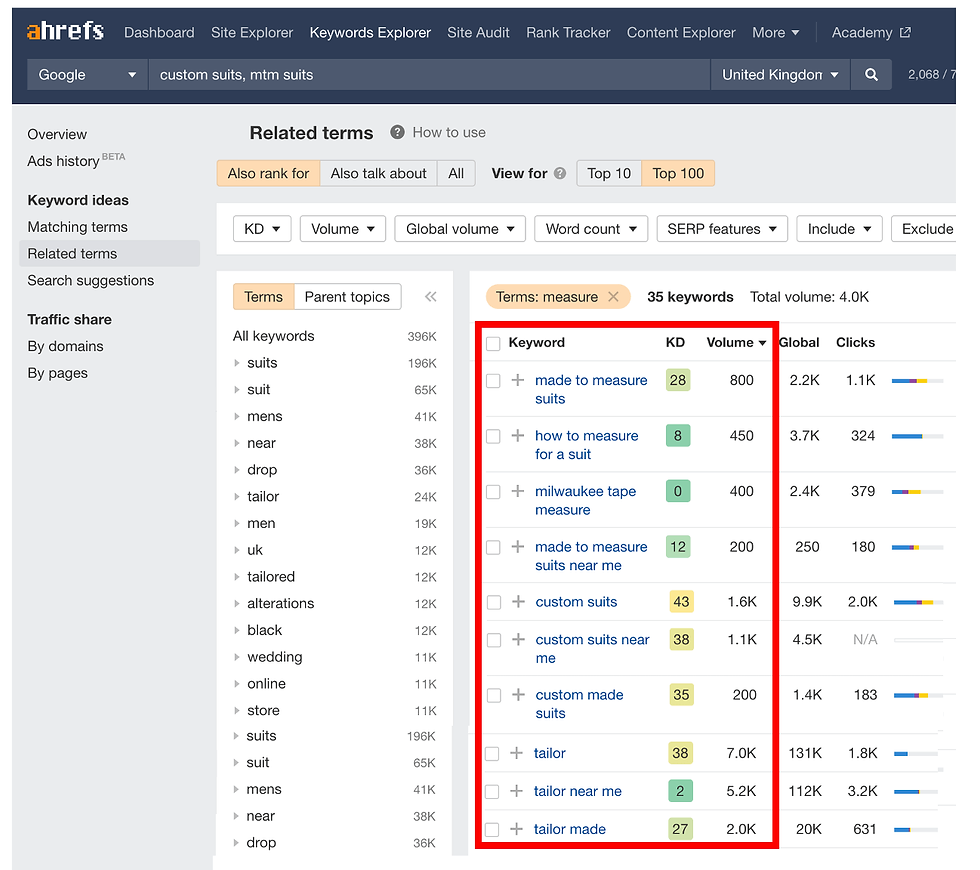
You can also use these keyword tools to conduct competitor analysis by simply typing in the website name of the competitor into the available search bar in the tool. In this way, you’ll be able to see a list of keywords that your competitors are ranking for that that are driving traffic from. By using this data, you can find out the keywords that they are ranking for and better optimize your website with the aim of stealing traffic away from them.
The next step is to narrow down your list of keywords so you can find those with the highest value for your campaign.
You should evaluate your keywords based on the following factors:
Keyword search volume. The higher the search volume, the more potential traffic
Competition: The lower the competition, the more likely you are to rank for that search term.
Relevancy: How relevant is your product page or service page to the given search term? There's no point trying to trick Google. They see everything.
Intent: Ensure your keywords show buying intent. Conversion rates, aka people actually making a purchase from these types of keywords, are often higher.
#4. Web page structure.
It might surprise you to learn that the design of your website structure influences so much more than the user experience itself. Additionally, it influences how easily search engines can find product pages on your website. Therefore, for anyone with products listed online, it is very important to get the site structure right. In a nutshell, your website structure is how users can navigate your website, how your website pages are laid out.
Your website structure should:
Be simple.
Make sure that every page on your site is only one click away from the homepage. Your users shouldn't have to click back or spin in circles to get where they are trying to go. In general, the further your products are removed from the homepage, the less importance you are telling Google that they have (also referred to as authority).
As a result, those pages with less authority are less likely to rank and less visible because search engines consider them less important.
Before allowing Google to determine what categories, filters, and attributes are worth indexing on your website, aka which pages Google will choose to rank (here's how to submit your website page for indexing using your Google Console account), there are three questions that you should ask yourself.
1. How relevant is the keyword that is used for the search?
2. Does your audience search for the term enough to compensate for the time and effort to index that page?
3. And do you have enough relevant products, services, and offerings to be featured on that index page?
One of the most common mistakes that SEO beginners make is having too much similar content cited on several pages.
eCommerce sites have a lot less rich content than news sites. Similarly, random product and attribute filters can result in content duplication problems of the same type. This occurs when the same content can be found throughout your site.
There's nothing worse for a search engine than having too much of the same. The reason for this is that search engines aren't sure which content to rank, and as a result can penalize entire pages or domain names.
#5. On-page SEO tactics.
Now that you have laid the foundation for your SEO success, it is time to optimize your two most important pages (for eCommerce stores):
your product page
and your product category page.
The following things need to be optimized:
Title Tag.
When you conduct a search on Google, the title tag is the blue clickable headline that appears on the results page (see image below).
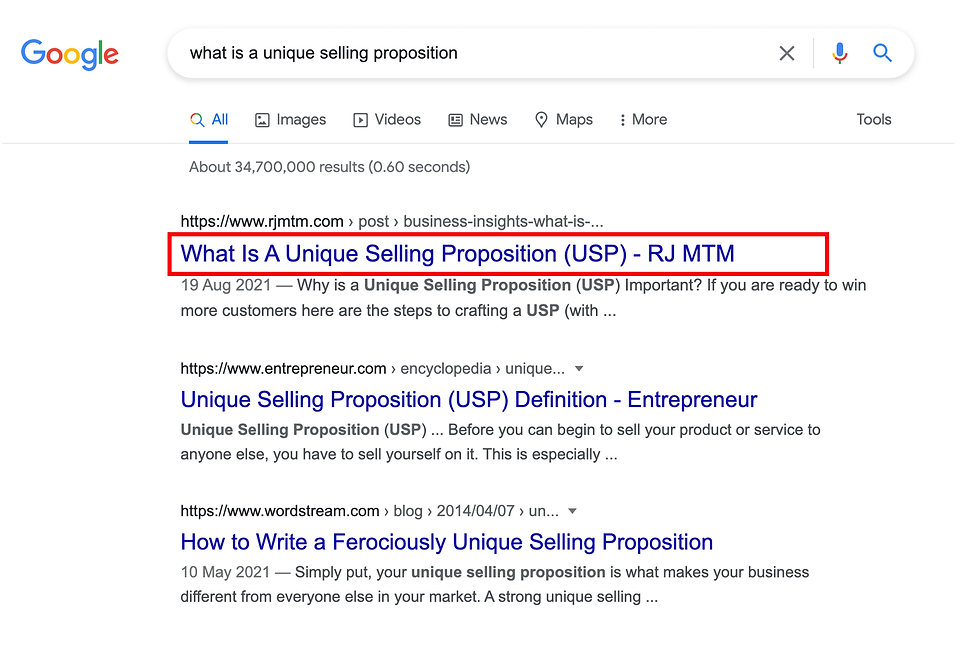
The following are the essential elements of an amazing title tag:
Google uses your title tag to determine the click rate, so make sure it is engaging.
Make sure to include your primary keyword in the title as it's sometimes important for rankings.
Your title tag should not exceed 60 characters so that it doesn't get cut off in Google.
Title tags should be descriptive of what your blog post or page is about. If you're writing an in-depth blog post, then use terms such as:
- Ultimate
- Definitive guide
- or step by step.
Make sure it’s short and sweet!
Furthermore, if your website platform provider doesn't automatically include the name of your brand after your headline, it is good practice to do so.
Ensure that all the title tags on your website are unique. It is possible that Google will penalize you in the future if they are not.
Meta descriptions.
Meta descriptions are basically the paragraphs underneath the blue headline on Google.

The meta descriptions checklist:
Ensure that your primary keyword and any relevant secondary keywords are included in your content.
It MUST be enticing enough to make the user click on your link.
Don't stuff them with unnecessary or repetitive keywords.
URL.
Next, we have your URL.
The URL should contain your main keyword phrase and be as short as three or four words.
A great idea is to get rid of words like:
at
the.
The URL checklist:
Make sure your URL matches your title as much as possible.
In order for search engines to not be confused, your URL must be different from other URLs on your site.
Images.
Now let's discuss images. Images with original content can help your website rank better, so always try to use original images on your website. You should always optimize images even if they are not original.
Let's look at the alt text first.
Alt text tells Google what the picture is about.
Adding this information to the image makes Google understand what's happening in it and how to rank it correctly. In the alt text, make sure you also include your keywords.
In addition, your media file names should include the primary keyword. Never upload a file without a description.
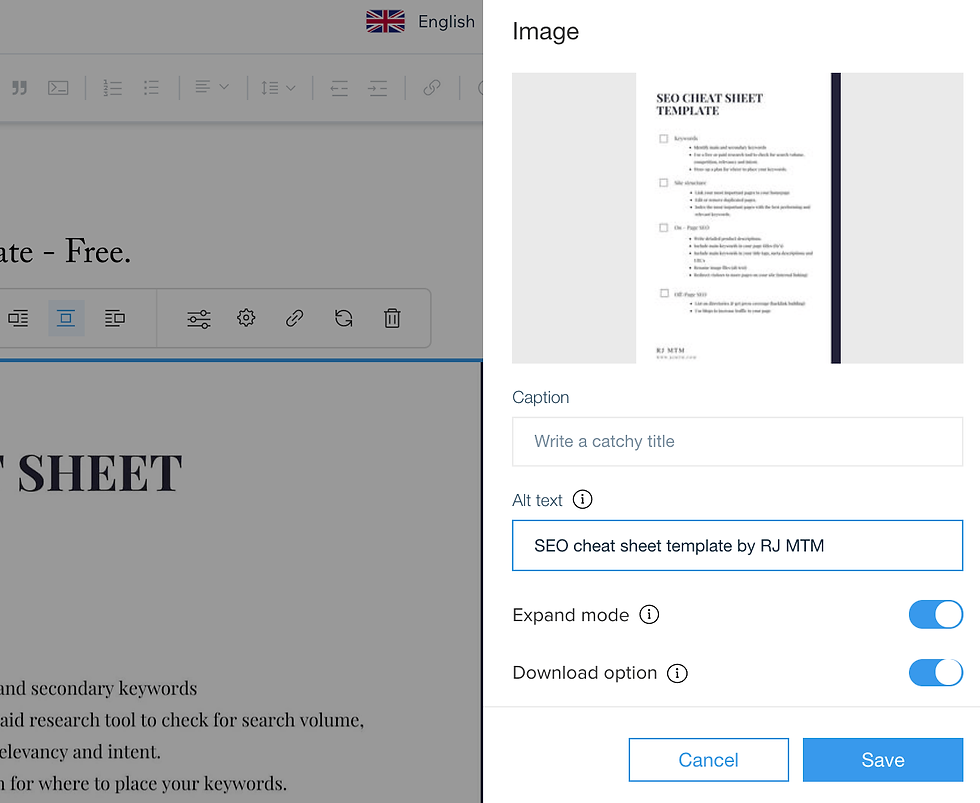
H1, H2, H3, what the heck?
Here we go header tags and the finer points. When Google crawls your website, header tags are crucial as they help Google understand the order of importance.
H1, H2, and H3 should always be formatted in a hierarchy, with H1 at the top and H5 at the bottom.
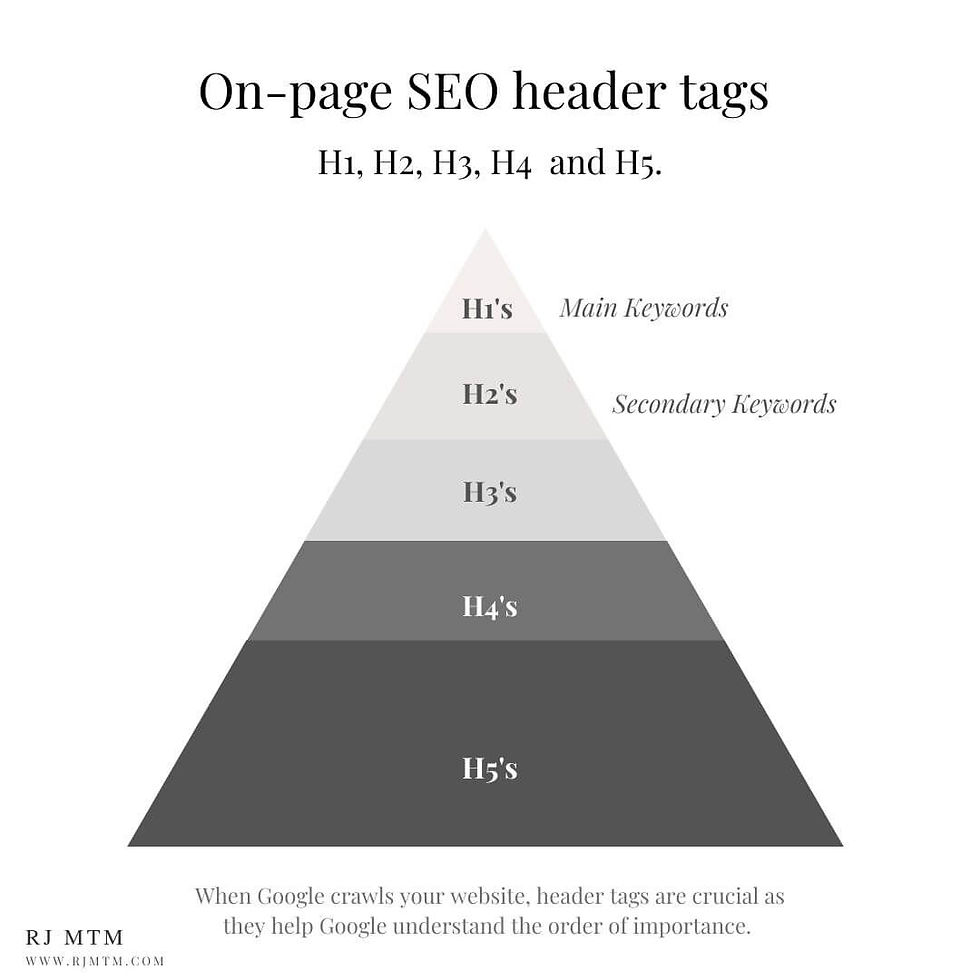
In your product descriptions, use header tags. Not only do they enhance your visitor's experience, but they also help Google bots more easily crawl your website.
Author's tip:
H1's are best for high impact keywords, while H2's and below are best for secondary keywords and long-tail keyword phrases.
For your website, make sure to set your most important titles (that’s called H1 within your website tool builder) with the main keywords you want to rank for.
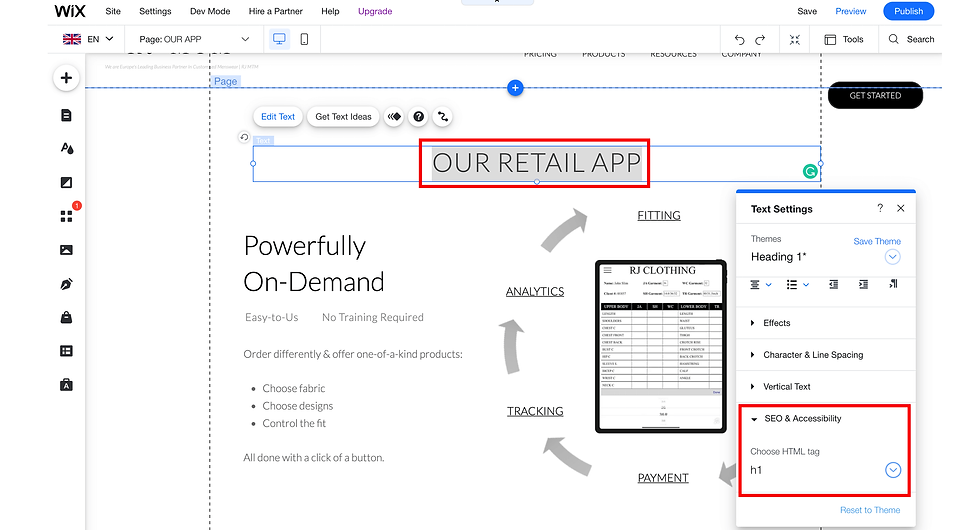
A second-best practice is to write rich product descriptions. Your product pages don't stand a chance if you write overly short product descriptions. This is why you must write detailed product descriptions.
Internal Linking.
Internal linking is also important.
In general, the longer visitors stay on your website, the greater your chances of getting a sale. By including links to other pages on your site, your customers can explore and discover new products that may interest them.
Make sure you include the keyword in your anchor text, which is where you actually place your link.
You can use internal linking to direct customers to other pages like RJ MTM's product page, or educational content like Instagram Marketing: Tools to grow your business account.
Author's tip:
Create content that assists your audience during each stage in the buyer journey by understanding their decision-making process.
Do not overdo internal links either. It's fine to put a link every few hundred words.
#6. Off-page SEO tactics.
Backlinks - External links.
Hooray! You´ve almost made it to the end.
The last topic we will talk about is backlinks (external links). I mentioned authority a bit earlier in this article, and I think the best way to explain it is to give an overview of Google's history.
Larry Page and Sergei Brin created Google in the course of their thesis work in an attempt to organize the entire internet.
After downloading the entire Internet (yeah, you read that right) they sought to improve search engine functionality. The authors propose giving authority to web pages instead of simply drawing results by keyword, much like how journals are given authority based on citations.
These citations are now known as backlinks and websites are given authority based on backlinks.
Even though Google uses hundreds of other ranking factors in their algorithm, they rely heavily on domain authority (aka domain trust), relevance, and backlinks to evaluate the reliability of a website.
Because of this, new sites appear to Google as having less authority.
While time can help fix this, building backlinks is one of the best ways to have search engines view you as an authority.
Respected:
.com
.gov
and .edu
sites will provide you with the most authority when they give you a backlink.
Building external links (backlinks) is best accomplished by focusing on partnerships. Identify other websites that have similar niches to yours and determine ways that you can offer mutual value.
You can also choose to list on directories like Weddingsonlie.ie or get mentions on other websites through sponsorships as ways to gain backlinks too.
A guest post can also be a meaningful way to build backlinks, provided that the content is relevant and offers real value for your readers.
You can analyse competitor’s backlinks (also known as a backlink audit) using the keyword tools mentioned earlier in this article. This is an excellent way to uncover backlink opportunities for your target market.

Press mentions are another way you can build backlinks. While constructing your own press list is labour-intensive, and hiring a PR agency can be extremely expensive.
With helpareporter.com, you'll receive a daily email digest of reporter requests. Respond to emails that match your brand and product with an email pitch. When you get an interview, ask for a link back to your website.
Author's tip:
Many of the bigger publications like Forbes and Elle Men do not even include the business name in their articles, let alone links. So do research before connecting.
Lastly, beware of backlinking services. Some companies might try to sell backlinks based upon quantity rather than quality. You can really hurt your SEO overall if you do this.
Invest time in building quality backlinks. Over time, you'll benefit greatly from it.
#7. SEO hiring checklist template - Free.
Here’s a general set of recommendations to have in mind as you go about hiring an SEO special.

Save as Image
#8. SEO cheat sheet template - Free.

Save as Image
That’s it for this first article! Congrats on getting started with SEO. I hope it will bring your business the boost it needs to increase sales and grow your brand recognition.
If you are interested in finding out how you can provide an exciting new product offering that customers in Ireland and UK are currently searching for, keep reading.
Design your own suit
Make your own jeans
Made to measure chinos
Above are some of the trending search terms coming from the UK and Ireland during the past few months. Menswear shop owners can now easily offer customers what they are searching for. Offering them the option to customise garment designs, colours, fabric weight, sizing, and much more by using RJ MTM's End-to-End Apparel Retail system.
Interested in seeing this for yourself? Take a Visual Tour with my colleague Frank. Find out how your store and brand can wow customers, keep them coming back for more products and do both of these things by lowering your monthly inventory costs by up to 50%! All you need to do is to send an email to Frank at info@rjmtm.com, telling him briefly about your business and a date and time that works best for him to call you. A no strings attached chit-chat to find out how your business can be transformed into a menswear super-powered temple.
If you found this article useful, make sure you give it a thumbs up so that I know what type of content you like. Also, if there are topics you like me to cover in future articles, let me know in the comment box below.
Cheers,
Camilla



Comments